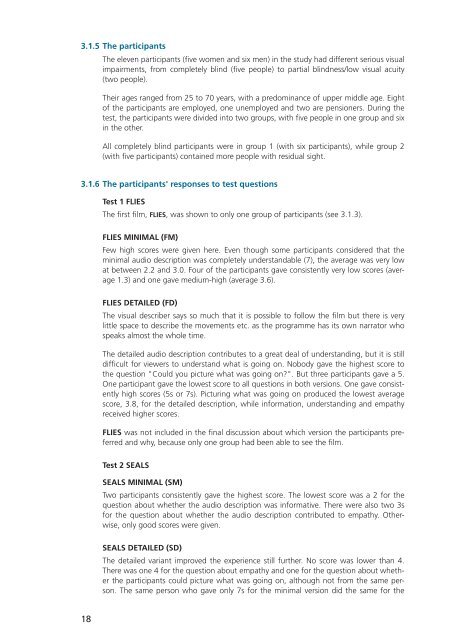AUDIO DESCRIPTION and AUDIO SUBTITLES
AUDIO_DESCRIPTION_and_AUDIO_SUBTITLES
AUDIO_DESCRIPTION_and_AUDIO_SUBTITLES
You also want an ePaper? Increase the reach of your titles
YUMPU automatically turns print PDFs into web optimized ePapers that Google loves.
3.1.5 The participants<br />
The eleven participants (five women <strong>and</strong> six men) in the study had different serious visual<br />
impairments, from completely blind (five people) to partial blindness/low visual acuity<br />
(two people).<br />
Their ages ranged from 25 to 70 years, with a predominance of upper middle age. Eight<br />
of the participants are employed, one unemployed <strong>and</strong> two are pensioners. During the<br />
test, the participants were divided into two groups, with five people in one group <strong>and</strong> six<br />
in the other.<br />
All completely blind participants were in group 1 (with six participants), while group 2<br />
(with five participants) contained more people with residual sight.<br />
3.1.6 The participants' responses to test questions<br />
Test 1 FLIES<br />
The first film, FLIES, was shown to only one group of participants (see 3.1.3).<br />
FLIES MINIMAL (FM)<br />
Few high scores were given here. Even though some participants considered that the<br />
minimal audio description was completely underst<strong>and</strong>able (7), the average was very low<br />
at between 2.2 <strong>and</strong> 3.0. Four of the participants gave consistently very low scores (average<br />
1.3) <strong>and</strong> one gave medium-high (average 3.6).<br />
FLIES DETAILED (FD)<br />
The visual describer says so much that it is possible to follow the film but there is very<br />
little space to describe the movements etc. as the programme has its own narrator who<br />
speaks almost the whole time.<br />
The detailed audio description contributes to a great deal of underst<strong>and</strong>ing, but it is still<br />
difficult for viewers to underst<strong>and</strong> what is going on. Nobody gave the highest score to<br />
the question "Could you picture what was going on?". But three participants gave a 5.<br />
One participant gave the lowest score to all questions in both versions. One gave consistently<br />
high scores (5s or 7s). Picturing what was going on produced the lowest average<br />
score, 3.8, for the detailed description, while information, underst<strong>and</strong>ing <strong>and</strong> empathy<br />
received higher scores.<br />
FLIES was not included in the final discussion about which version the participants preferred<br />
<strong>and</strong> why, because only one group had been able to see the film.<br />
Test 2 SEALS<br />
SEALS MINIMAL (SM)<br />
Two participants consistently gave the highest score. The lowest score was a 2 for the<br />
question about whether the audio description was informative. There were also two 3s<br />
for the question about whether the audio description contributed to empathy. Otherwise,<br />
only good scores were given.<br />
SEALS DETAILED (SD)<br />
The detailed variant improved the experience still further. No score was lower than 4.<br />
There was one 4 for the question about empathy <strong>and</strong> one for the question about whether<br />
the participants could picture what was going on, although not from the same person.<br />
The same person who gave only 7s for the minimal version did the same for the<br />
18


